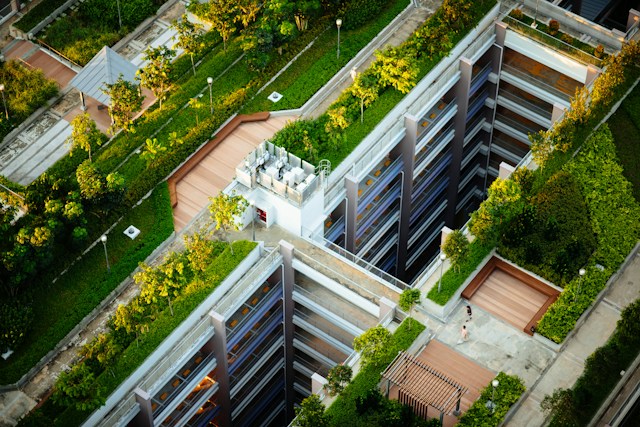What impact does green building certification have on property values and energy savings?

As our world becomes increasingly aware of the urgency of environmental issues, green building certifications are becoming more and more pertinent in the real estate market. Over the past decade, there has been a noticeable shift towards sustainable and environmentally friendly practices in various industries, but particularly in the realm of real estate. A green building certification such as LEED (Leadership in Energy and Environmental Design) signals to property owners and potential buyers that a building is energy efficient, reduces water usage, and minimizes its overall environmental impact. But what exactly does this certification mean, and how does it affect property values and energy savings?
The Meaning and Significance of Green Building Certification
First, let’s delve into the significance and meaning of green building certifications. These are essentially seals of approval given by third-party organizations that validate a property’s sustainability and efficiency. One of the most globally recognized certifications is LEED, but there are various others, such as Green Star, BREEAM, and WELL.
A découvrir également : How can AI-driven personalized education improve student outcomes in schools?
The certification process involves a rigorous assessment of the building in context to various dimensions of sustainability. These may include the efficient use of energy and water, reduction of waste, use of sustainable materials, indoor environmental quality, and the building’s impact on the ecosystem.
Having a green certification is a badge of honor for a building. It demonstrates the commitment of the property owners or developers to sustainability and environmental responsibility. Moreover, it’s a quantifiable measure of a building’s environmental impact. In essence, it’s not just about being ‘green’ in name but about engaging in verifiable, sustainable practices that benefit both the environment and the building occupants.
En parallèle : What are the cultural influences on sustainable dietary choices around the world?
Impact on Property Values
With a clear understanding of what green building certification entails, let’s now explore how it influences property values. There’s a growing body of evidence to suggest that green certifications have a positive impact on a property’s value.
Several studies have indicated that LEED-certified buildings command higher rents and sales prices compared to non-certified buildings. This is attributed to several factors such as increased market demand for green buildings, lower operating costs due to energy and water savings, and perceived higher quality of indoor environment.
According to a 2017 report from the U.S. Green Building Council, LEED-certified homes had an 8% boost in value compared to their non-certified counterparts. Similarly, a study published in the Journal of Sustainable Real Estate found that green certified buildings in the commercial sector achieved a premium of 29% on sale prices.
Furthermore, green certification can also be a valuable selling point in a competitive real estate market, making the property more attractive to prospective buyers or tenants who prioritize sustainability and are willing to pay a premium for it.
Impact on Energy Savings
Beyond potentially elevating property values, green building certification also has a significant impact on energy savings. Buildings are one of the largest energy consumers in the world, accounting for nearly 40% of global energy consumption. Therefore, making buildings more energy efficient can substantially reduce global energy demand.
LEED-certified buildings, for instance, are designed to be energy efficient from the ground up. They utilize advanced technologies such as energy-efficient appliances, LED lighting, and high-performance HVAC systems. The building design also typically incorporates elements that maximize natural light and ventilation, further reducing the need for artificial lighting and air conditioning.
A study conducted by the New Buildings Institute found that LEED-certified buildings, on average, had 25-30% lower energy use compared to the national average. This translates into substantial energy cost savings over the lifespan of the building. Moreover, energy-efficient buildings contribute to the mitigation of climate change by reducing greenhouse gas emissions associated with energy production.
The Environmental Impact of Green Building Certifications
The environmental benefits of green building certifications are undeniable. Certified buildings are designed to have a lower environmental footprint by reducing energy and water consumption, minimizing waste, and using sustainable materials.
For example, LEED-certified buildings are estimated to consume 25% less energy and 11% less water than non-certified buildings. They also generate approximately 34% fewer greenhouse gas emissions. These buildings are also likely to incorporate features such as rainwater harvesting, green roofs, and waste recycling programs, all of which contribute positively to the environment.
By encouraging the construction of more sustainable and efficient buildings, green building certifications play a pivotal role in global efforts to mitigate climate change, conserve natural resources, and protect biodiversity.
The Larger Picture: Green Building Certification and the Drive Towards Sustainability
As we grapple with the realities of climate change and resource depletion, the adoption of green building practices becomes a necessity, not just an option. Green building certifications such as LEED have an instrumental role in driving this transition.
On a tangible level, they encourage property developers and owners to incorporate sustainable practices in their projects, resulting in buildings that consume less energy, use water more efficiently, and have a smaller environmental impact. This not only yields benefits in terms of energy savings and potential property value uplift but also contributes to broader environmental and societal goals of sustainability and climate resilience.
In conclusion, a green building certification is not just a plaque on the wall. It is a testament to a building’s sustainability credentials and a key indicator of a property’s efficiency, value, and environmental impact. As the world moves towards a more sustainable future, such certifications will increasingly become the norm rather than the exception in the real estate landscape.
The Correlation Between Green Building Certification and Indoor Air Quality
It’s crucial to acknowledge that one of the key components of green building certifications is indoor air quality. Air quality within the built environment can significantly affect the health and well-being of the occupants. Given that most individuals spend the majority of their time inside buildings, the air quality inside these spaces is a critical consideration.
Certified buildings, such as those with a LEED certification, are designed and operated to maintain excellent indoor air quality. The certification criteria include measures that enhance ventilation, reduce indoor air pollutants, and maintain a comfortable temperature and humidity level. This not only results in a healthier indoor environment but also leads to increased productivity and satisfaction among the building users.
For instance, a study conducted by the Harvard University’s School of Public Health found that people working in offices with superior indoor environmental quality (characteristic of green certified buildings) had higher cognitive function scores compared to those in conventional offices. This shows how these certifications not only contribute to the environmental health but also directly impact human health and productivity.
Green Building Certifications and Cost Savings
While the initial cost of incorporating green building practices and achieving certification can be higher than traditional practices, the long-term cost benefits are significant. The energy efficiency measures in certified buildings translate into considerable cost savings in utility bills.
Building certification programs like Energy Star and LEED emphasize the use of energy-efficient appliances and systems. These include energy-efficient lighting, HVAC systems, and insulation, among others. These features significantly reduce the energy consumption in buildings, leading to substantial cost savings in the long run.
According to a report from the U.S. Environmental Protection Agency, Energy Star certified buildings save an average of 35% in energy costs compared to typical buildings. Similarly, a study by the New Buildings Institute showed that LEED certified buildings demonstrated, on average, 24% lower energy costs than non-certified buildings.
In essence, the cost savings from energy efficiency measures can offset the initial investment made to achieve the green certification. Over time, the savings can even surpass the initial cost, making the investment in green certification financially feasible and attractive.
Key Takeaways and Future Perspectives
In conclusion, green building certifications play a pivotal role in the current real estate landscape. They not only enhance the value and marketability of the properties but also ensure significant energy savings and provide healthier indoor environments. With such benefits, green building practices, substantiated by certifications, are increasingly becoming the new standard in the real estate industry.
As the awareness of environmental issues intensifies, the demand for certified buildings is expected to rise. Property owners, developers and potential buyers are recognizing the myriad benefits that these certifications offer – from reduced operating costs to enhanced indoor air quality and a lower environmental footprint.
As we move forward, the adoption of green building certifications will not only be a crucial factor in combating climate change and resource depletion but will also be a key component in the global drive towards sustainability. The real estate industry, with its significant impact on the environment, has a vital role to play in this transition. Hence, green building certifications will undoubtedly continue to gain importance and become an integral part of future building practices.
